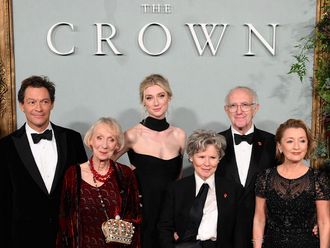
“A high-end TV really is a large-screen smartphone,” says Paul Gray, a director at NPD DisplaySearch, a leading display market research company.
While the modern smart TV may not be able to make phone calls, it can pretty much do everything else. However, there is a crucial difference between the TV and smartphone — their upgrade cycles. NPD’s Global TV Replacement Study reveals that TVs are upgraded every six to eight years, while smartphones average two years of use.
This also means TVs are a hard sell, and marketing departments tend to go overboard hyping up the latest features and technologies. But, to be fair, there have indeed been a few exciting innovations in TV tech. In fact, this may be a great time to seriously consider upgrading your set.
Curved displays
Screens are going bananas, literally. Samsung and LG have launched not just phones, but also TVs with curved displays. The main advantage of a curved phone is easy to imagine — hold it next to your ear and it snuggles nicely along the contours of your face. But the advantages of a curved TV are mostly a trick your mind plays on you – they are perceptual and intangible.
What’s hot is that a curved display increases immersion as the screen appears to wrap around you. There’s an increase in depth, a wider viewing angle and better contrast as well.
However, due to the curve, it is difficult to mount these TVs on a wall. A bigger drawback is that curved screens look best head-on or up to 35-40 degrees off-centre. This means you cannot have a group of people scattered all over the room watching the TV.
Plasma TVs will soon disappear from the market, but they retain a loyal band of believers who will advise you to grab one while you still can. Plasmas are great value for money; they offer deep blacks and good colour reproduction. But they are thicker, slightly dim, consume a lot of power and are, at least in popular perception, old tech.
LCDs are currently the most popular choice. You can buy them in massive sizes, and the screens offer better contrast and sharper images, but viewing angles are limited. On the cheaper sets — those without complex motion interpolation — you often see artefacts and blur.
OLEDs are the new kids on the block, but they will cost you a pretty penny. You have already seen this tech on smartphones, but as DisplayMate Technologies puts it, “Producing a large-screen OLED TV is considerably more difficult for many reasons — for one, a 55-inch TV screen has 121 times the area of a five-inch smartphone.”
But they offer the best of all worlds: the sharpness of LCDs, the wide-viewing angles of plasmas and no noticeable motion blur. For backlighting, they use an emissive electroluminescent film.
Resolution speak
Four times the resolution of your current HD TV — who would say no to that? While current full-HD 1080p TVs deliver pictures at 1,920x1,080 pixels, UHD (2160p) ramps it up to 3840x2160 pixels. This is one piece of technology you should invest in.
But the question is, when? Buying an expensive 4K TV today may not make much sense, but buying a cheaper 4K TV a year from now will make lot of sense. 4K TVs flaunt details like you have never seen before. Whether it’s a football match or the next Spielberg movie, 4K will usher in unparalleled immersion and realism.
But its biggest drawback currently is the lack of content, whether on broadcast media or on discs. It is still a demo technology that you can show off to your friends, but actually do very little with.
Smart TVs
TVs went smart a few years ago and, aside from a bundled suite of apps, they pull real-time information from the internet. The current crop has refined the apps package and significantly improved the user interface. And with the inclusion of motion sensors and gesture control, navigating the menus is not as clunky.
What’s great is that your TV does a lot more. You can surf, play games, stream videos and even get some work done using, for example, Google Docs. Pair it with a Bluetooth keyboard, and you may not need a computer or smartphone for many tasks.
But in most cases, you are stuck with the smart technology that is inside — and it will become dumb in just a couple of years. Samsung has tried to address this issue with its Evolution series, where you replace only the smart kit instead of the entire TV, but the kit is expensive.
We recommend an Android stick PC, which will turn any standard TV smart, and give you access to countless apps in the Google Play Store. These sticks are cheap enough to throw away a year later.
3D TV
They were supposed to be the next big thing in TVs - that is, until the next, next big thing arrived. There are two types - the “active” ones that require shutter glasses, and the passive ones that use polarised glasses. Currently, Samsung is the only major player pushing the former. They offer a more immersive experience, but the glasses need to be charged regularly and suffer from flicker. Though most LCD makers have switched to passive – the glasses are cheaper and easier to maintain - the downside to this tech is that pictures often look jagged and low res.
3D is now languishing as just another feature that you get with an expensive TV, whether you wanted it or not. However, it is likely to make a resurgence with the rise of 4K TVs - 3D looks jagged because it halves the display resolution, but with 4K sets, that won’t matter. The picture will remain stunning. Also, glasses-free 3D is expected to meet a better fate than current 3D tech. However, we still have a few years to go before such TVs come in large sizes at affordable prices.
8K
If you thought 4K was the pinnacle of TV resolution, well, 8K is coming soon. That’s a staggering 4320p or 7680x4320 pixels. Japan’s NHK has teamed up with Fifa to test 8K broadcasting during the World Cup 2014, and will start beaming at that resolution in 2016. Meanwhile, at CES 2014, Sharp demoed a couple of 8K TVs - one of them with glasses-free 3D tech. But 8K TVs will take time to reach the lay consumer, and finding enough content to justify buying one will take even longer. But rest assured, 8K will surely be the next, next, next big thing in TV.












